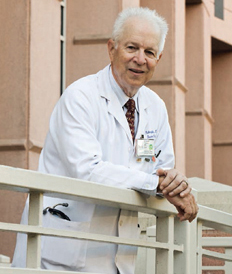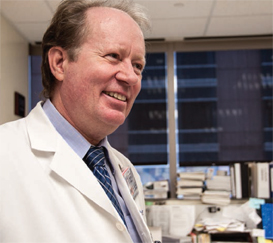More choices for transplant mean more patients benefit
Though the field began with bone marrow transplants, today most transplants use blood-forming stem cells as patients' choices become more diverse and personalized.

Lives interrupted. Lives reset.
Dylan Smart was a star baseball player who had just celebrated his 16th birthday when doctors discovered his brain tumor.
Darshe Edge had just completed her third year of medical school and was studying for the boards when she learned she had acute myelogenous leukemia.
Cesar Talamantes was a hard-working bulldozer operator at a Louisiana construction site when he was diagnosed with lymphoma.
Laura McKensie was studying for her CPA exam and had just become a grandmother for the first time when she got the news of her leukemia diagnosis.
Newlywed Cristina Rodriguez was a popular Zumba instructor and sang in her church choir when her lymphoma was confirmed.
A cancer diagnosis may have put the brakes on the lives of these people, and more than 13,000 adult and pediatric patients since 1991, but a bone marrow, stem cell, cord blood or rescue transplant literally and figuratively reset their futures.
MD Anderson is home to the largest hematopoietic (the formation of blood or blood cells in the body) transplant program in the world, last year doing 848 adult transplants, just shy of its record 865 transplants in 2011. The number of procedures last year was nearly triple the 293 transplants in 1991, which marked the beginning of the surge in progress that continues today.
Even before the early 1990s, MD Anderson was a leader in developing the procedure, performing the first bone marrow transplant in 1975 when the service was part of the Department of Hematology. By the end of the 1980s, MD Anderson had grown to the second largest program in the nation.
More than just statistics
The incredible progress in hematopoietic transplantation reflects myriad back stories that have led to great advances, including:
- clinical collaborations,
- basic research findings,
- translational development of new, less toxic and more effective pretransplant
chemotherapy programs, - extraordinary multidisciplinary clinical teams,
- sophisticated processes for cell preparation,
- new technologies for finding matches around the globe and, most recently, to use “alternative donors” who are not perfect tissue-type matches,
- outstanding nursing care and an improved inpatient environment,
- better infection control and improved drugs to treat complications, and especially
- courageous patients.

Richard Champlin, M.D.
Photo: John Everett
“We now are at a point in time where we have a transplant option for virtually every patient who could benefit,” says Richard Champlin, M.D., professor and chair of the Department of Stem Cell Transplantation and Cellular Therapy.
“When I came to MD Anderson, we were transplanting only young patients under age 45 with certain types of leukemia, and only using a tissue-type matched family member as the donor. Today, we can transplant patients with a wide range of cancers, particularly those of the blood and lymphatic system. We can now perform transplants in older patients up to 75 years old and successfully perform transplants using HLA [human leukocyte antigen] tissue-type mismatched donors.”
Personalized choices
Research during the past two decades has produced a number of new approaches for transplants. The field began with bone marrow transplants, but now most transplants use blood-forming stem cells from the peripheral blood or from umbilical cord blood.
As in so many other disciplines in cancer care today, the choices are more personalized. These choices are based on the patient’s disease, condition and outlook, overall health, the availability and health of a family member or unrelated donor to be a match, and other clinical factors.
With these approaches emerging and improving, more patients have a better chance at not only getting a transplant, but also of surviving it and curing the disease.
- Autologous stem cell transplants extract a patient’s own stem cells, through a simple process called apheresis, and cryopreserve (freeze) them before re-infusing them into the patient. This is a successful treatment for many forms of lymphoma, multiple myeloma and germ cell cancers.
- Allogeneic stem cell transplants take stem cells from a normal donor. This is effective treatment for leukemias, other hematologic malignancies and severe nonmalignant diseases of the blood or immune system.
- Bone marrow transplants extract stem cells from the marrow in a donor’s pelvis or hip, treat and infuse them into the patient.
- Peripheral blood stem cell transplants involve blood-forming stem cells collected from the blood using apheresis, the same procedure used to collect platelet transfusions.
- Cord blood uses stem cells from a donated placenta and umbilical cord.
- Mini- or non-myeloablative transplants use lower dose, less toxic chemotherapies in advance of the transplant. This has improved the safety of hematopoietic transplantation.
- Haploidentical transplants infuse stem cells from a less than perfectly matched related or unrelated donor.

Borje Andersson, M.D., Ph.D.
Photo: John Everett
In addition, combining IV Busulfan, developed in-house by Borje Andersson, M.D., Ph.D., with a newer class of chemotherapy agents, has produced full-dose-reduced toxicity pretransplant conditioning programs. These programs have set a new standard for how to safely and effectively perform stem cell transplants in leukemia patients.
“It’s impossible to express the relief and satisfaction of having so many effective and safe options for so many more patients,” says Andersson, professor in the Department of Stem Cell Transplantation and Cellular Therapy. “In the early days of transplant about half of our patients died, which was tragic. Now, in the most favorable scenarios, about 90% survive and stay in remission. Still, our patients grapple with some tough obstacles and complications, and we must do better for them.”
Common side effect: Graft versus host disease
A major remaining hurdle with allogeneic hematopoietic transplants is graft versus host disease (GVHD). This condition occurs when immune cells from the donor attack the recipient’s normal tissues. GVHD can appear suddenly within the first 100 days after a transplant and a chronic form can develop within the first year. Symptoms may range from rash, diarrhea and hepatitis to nausea and dry eyes. Methods for prevention and treatment of GVHD have markedly improved in recent years.
While treatable, GVHD is one of the chief reasons patients must be closely monitored and kept in the hospital for an extended time. It is most common in patients who have an unrelated donor, which is about 50% of transplants now, with the percentage expected to rise in the coming years as our population diversifies even more.
Preventing GVHD is a top research priority for MD Anderson because of the impact the condition can have — and has had for many years — on patient outcomes and quality of life. By preventing or minimizing the condition, patients can be spared one more health threat and additional treatment, which may extend their recovery from a transplant. However, some drugs given to treat it can suppress successful engraftment of the stem cells.
A study by Stefan Ciurea, M.D., assistant professor in the Department of Stem Cell Transplantation and Cellular Therapy, showed that giving patients cyclophosphamide after their haploidentical transplant prevented GVHD by about 70%. This figure is almost equivalent to the rate of this side effect in patients who have transplants using matched, related donors. This approach significantly improves the outcomes of haploidentical transplant patients, making results comparable with matched transplants, and allows clinicians to extend transplantation to virtually all patients in need.
Champlin says that engrafting donor immune cells rebuilds the immune system. The high doses of chemotherapy given before the transplant kills most, but usually not all, of the cancer. The immune reaction of the donor cells against residual cancer cells is what ultimately cures the malignancy.
Protection from infection
Following a hematopoietic transplant, the immune system is very weak for the first several months, and severe infections can occur.
Twenty years ago, MD Anderson patients were isolated for more than a month in tiny rooms in the “protected environment” — at the time, a pioneering approach to protect immunocompromised patients from infection. Today, physicians have extended the important features of the protected environment with advanced HEPA-filtered air with positive-pressure ventilation to the entire Albert B. and Margaret M. Alkek Hospital where transplant patients are cared for.
Now, stem cell transplant patients stay in normal-appearing hospital rooms. Family members can also stay comfortably with them in a large, bright room complete with artwork and computer access. There is even a small gym and structured exercise programs on the unit that not only help patients restore their strength and stamina, but also encourage socializing.

Advanced Practice Nurse Joyce Neumann, who has
worked in transplantation at MD Anderson for 21
years, reviews a patient's progress with Clinical
Nurse Aidee Neumann, who not only works on the
inpatient transplant unit, but also happens to be
her daughter-in-law.
Photo: Wyatt McSpadden
Nurses play a critical role
Transplants today have spurred changes in the hospital environment, nursing care and the patient experience. Still, transplant can be a grueling physical and emotional challenge, and support is vital to keeping patients motivated.
MD Anderson has a group of outstanding nurses, dedicated to the care of stem cell transplant recipients. Transplant nursing has also evolved, led by many advances made by the institution’s nursing staff.
MD Anderson’s 2,800 nurses are among the nation’s most skilled critical thinkers, caregivers, educators and advocates for their patients. Nurses who work in the transplant clinic and unit find their patients’ clinical and emotional needs can be even more magnified.
Joyce Neumann, clinical nurse and program manager of the Bone Marrow Transplant Unit, has worked in transplant for 21 years and manages 20 mid-level providers. She says that caring for transplant patients is distinctive.
“Nursing is important with any population, but especially with this group of patients,” Neumann says.
“We give them a very intense treatment for a lethal cancer that presents a huge physical and emotional burden for patients and their caregivers. These patients can become very sick very quickly and that level of uncertainty can be frightening. We, as nurses and mid-level providers, must be attuned to the slightest clinical changes while helping them manage their burdens.”
Nurses monitor and motivate
For Karen DeYoung, inpatient clinical nurse, who has worked on the transplant unit since 2010, one way to help patients manage their treatment is by talking to them about what motivates them to get better — listening not to their fears, but about their family, pets or work. Outside the patient’s room, in the team room, it’s about extending that same care to colleagues.
“The transplant unit is fundamentally one step below the Intensive Care Unit,” DeYoung says. “We have to work together to watch for the slightest change in a patient’s condition or demeanor and respond quickly, whether it be to call on another nurse, physician, a respiratory therapist, social worker or physical therapist.”
For her colleague, Lourine Davis, who has been a nurse for 22 years, it’s all about showing care and compassion. In February, Davis and some of the nurses on the unit planned a wedding in MD Anderson’s chapel for a patient and his long-time fiancée, who was at his bedside constantly.
“Every day, I come to work and want to make a difference in the lives of these patients,” she says. “We all are passionate about making sure they have the resources they need.”
Lives reset
Dylan Smart, who was infused with his own stem cells last year as a rescue transplant after high-dose chemotherapy, still loves baseball. He volunteers with the Children’s Cancer Hospital’s Teen Advisory Council and hopes to be an MD Anderson child life specialist.
Darshe Edge, M.D., is two years out from her double cord-blood transplant. She is a medical resident, who recently completed an MD Anderson rotation and is considering oncology as a specialty.
Cesar Talamantes had his stem cell transplant in 2010, thanks to his oldest sister who was a match. Despite life-threatening complications and GVHD, he is back to work at a Houston restaurant.
Laura McKensie had her bone marrow transplant in February 2001 and continues to struggle with GVHD. Despite her condition, she exercises five days a week and hopes to return to work later this year. She has three healthy grandchildren, one of whom was diagnosed with leukemia at the same time she was being treated.
Cristina Rodriguez is recovering from her December 2012 haploidentical bone marrow transplant and blogging about her cancer experience. She plans to return to Corpus Christi, Texas, with her husband and parents in the near future.
Related story:
“It’s impossible to express the relief and satisfaction of having so many effective and safe options for so many more patients.”

Faster, safer transplants
Last December, Elizabeth Shpall, M.D., and Ian McNiece, Ph.D., both professors in the Department of Stem Cell Transplantation and Cellular Therapy, published a paper in the New England Journal of Medicine showing that donated umbilical cord blood establishes a new blood supply in patients more quickly after transplantation when it is first expanded in the lab on a bed of cells that mimics conditions in the bone marrow.
Cord blood has become an increasingly vital source of cells for patients who need a transplant but may not have a donor. The difficulty has been the low volume of cells in the cord blood, which leads to a longer engraftment period and leaves patients vulnerable to infection and bleeding.
To increase the number of these cells, Shpall, McNiece and their team took blood from one of two donated umbilical cords and expanded it in the lab on a bed of mesenchymal cells. The expansion increased the number of total cells transplanted 12-fold and key engraftment cells by 40-fold. As a result, the cells engrafted and built a blood supply faster, which means a safer transplant.












